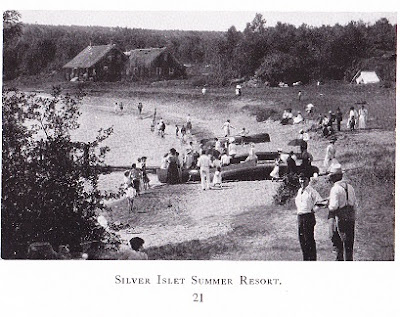Written, illustrated and published by
W.S. Piper, Fort William, 1918
Nipigon Historical Museum Archives
 |
| Old Silver Islet Mine, 1918 |
 |
| Silver Islet Summer resort, 1918 |
The morning broke clear with a nice breeze off the land, so I asked Luke concerning fishing for speckled trout. He said: "As there is a breeze blowing we had better not try for trout off the reefs, but sail out on deep water and put out the troll." But for the trout of the reefs I protested feebly. "Oh, no, Mister, too many nets here; I will take you later where you will get speckled trout." this was decided on, so I started the engine and we were soon clear of the islands, and, when well out on the deep water, I shut down and hoisted the sail. For three hours I trolled, catching three silver and one gray trout. By this time I felt highly elated and remarked to Luke, "Some catch, eh?" "Not bad, Mister." But I felt worthy of more applause.
Turning toward the shore I beheld a peculiar formation. The peninsula that divides Black Bay from Sturgeon Bay, called Magnet Point, seemed to take the form of a human Hercules, the head lying slightly lower than the body, the breasts very prominent, the limbs partly covered with water, and feet protruding. At one time the Indians blamed this formation for all their trouble. it is a common saying among Indians to this day that when an Indian does wrong that he should be sent to Matchee-Manitou to scratch his feet. This is supposed to typify Satan, the old serpent. On how he came to make Magnet Point his resting place authorities differ. According to one of the legends, he made war against Nanna- Bijou, a servant of the great Manitou, and was seriously wounded. This provoked the wrath of the old serpent, who, hoping to destroy Nanna-Bijou and all the animal creation, entered into the water and blowing his venom into it, caused the oceans to boil up and overflow the land. Nanna-Bijou, seeing the waters rising, built a great raft, saving with it a species of all animal life. After the water subsided, Matchee-Manitou, in the form of a great giant, appeared on Lake Superior. As he approached the Great Thunder Eagle he was struck by lightning, and , falling across Magnet Point, his back was broken, thus forming the strange formation.
 |
| Nanna-Bijou, the Sleeping Giant of Thunder Cape, 1918 |
As we neared the No. 10 Lighthouse the keeper ran down to the water's edge and hailed us. I thought it was an S. O. S. and that something was wrong, so we turned in. His delight was truly pathetic, as no one had called there for eight weeks. He asked about the war and other current events, and one seldom gets such an appreciative audience. We gave him some newspapers, fruit and cigars, and spent a couple of hours pleasantly on the island, leaving with the feeling that we had never known how glad one could be for the mere presence of human companionship.
We then ran for the old Hudson Bay harbor where we cast anchor.
Taking the tender we rowed to the reefs about two miles off where the water was deep and blue - blue as a sapphire. I handled with care my two new and expensive fishing rods which were accompanied by numerous different flies. I knew I had been extravagant and I gloried in it. Carefully adjusting a large brown hackler to my line, I cast, keeping my fly in the air and winging it about like a thing alive. I lightly deposited my offering on the crystal platter, which was immediately accepted. I had hooked a coaster. On feeling the metal in his mouth he made for the open lake, sending my reel spinning. Suddenly my line slackened; he leaped from the water. I reeled in, then let it spin out; his dashes for freedom being most beautiful. After playing him for almost twenty minutes he began to tire and Luke landed him with the net. he was a lovely speckled trout 18 inches long. I hooked two more that evening 14 inches long and packed them in a box of moss covered with ice.
TO BE CONTINUED
No comments:
Post a Comment